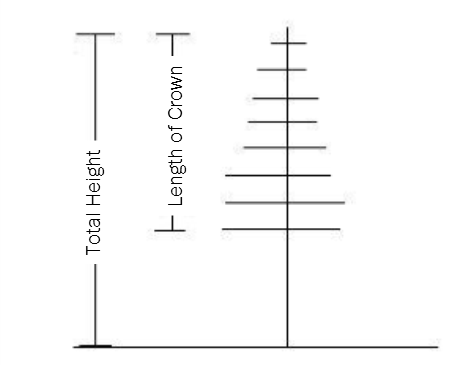5.3 Live Crown Ratio
A useful measurement to indicate tree vigor is live crown ratio (LCR). This is the ratio of crown length to total tree height, or the percentage of a tree’s total height that has foliage (Figure 5.7).

[latex]\text{Live Crown Ratio=}\left( {\frac{{\text{Length of crown}}}{{\text{Total tree height}}}} \right)\left( {100} \right)[/latex]
Crown length is partly a function of species’ shade tolerance. For example, Douglas-fir and most pines will self-prune (drop their lower branches as they become shaded). However, a shade tolerant species such as western hemlock will keep more lower branches in medium shade. Therefore, a western hemlock will have a longer crown (and higher LCR) under low light conditions than a Douglas-fir. Consider the data in Table 5.2. This young, evenaged forest stand (≈ 40 yrs.) was growing on a southern slope. It had a substantial riparian component supporting the hardwoods. Note that the red alder, cherry and Douglas-fir had shorter LCR’s than the more shade tolerant hemlock and cedar. The hardwoods were shorter, but all the conifers were approximately the same height.
|
Table 5.2. Mean Live Crown Ratio (LCR) and Height by Species for an Evenaged Stand in the Latourell Creek Watershed, Corbett, OR. Source: Data collected by Mt. Hood Community College Forest Measurements I class March, 2003. |
||
|---|---|---|
| Species | LCR(%) | HT (ft.) |
| Red alder | 40 | 62 |
| Bitter cherry | 28 | 52 |
| Douglas-fir | 43 | 74 |
| Western redcedar | 74 | 80 |
| Western hemlock | 64 | 78 |
Douglas-fir trees in this region with large crown ratios (>50%) tend to be dominant trees, and/or trees growing with adequate light. Douglas-fir trees with ratios of less than 30 percent generally have low vigor, and typically either a) occupy intermediate or suppressed crown classes, or b) are growing in very dense, uniform young stands. In the latter case, their root systems do not develop well, and the trees become subject to windthrow over time. These “dog hair stands” are often a result of planting seedlings at a high density, and failing to thin them later at the appropriate time.
In general, LCR will reflect crown class, regardless of species. Trees growing in the dominant crown classes tend to have the longest crowns overall, followed by trees in the codominant, intermediate, and suppressed crown classes respectively (Table 5.3). The exception to this may be unevenaged or two-aged stands in which distinct second and third layers are composed primarily of shade tolerant trees. In these cases, each layer must be evaluated independently.
| Table 5.3. Mean Live Crown Ratio (LCR) by Crown Class in an Evenaged stand near Larch Mountain, OR. Source: Data collected by MHCC Forest Measurements I class January 2003. | ||||
|---|---|---|---|---|
| Species | Mean LCR by Crown Class | |||
| D (%) | C (%) | I (%) | S (%) | |
| Douglas-fir | 48 | 47 | 38 | |
| Western hemlock | 50 | 37 | 39 | 35 |
| Overall | 49 | 42 | 38 | 35 |

